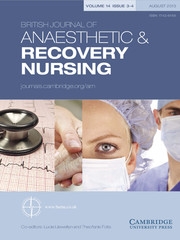Article contents
Determining the Effective Length of Stay for Post-operative Patients in the PACU through the Location of Influencing Factors
Published online by Cambridge University Press: 01 August 2009
Abstract
(1) Estimating actual post-anaesthesia care units (PACU) length of stay (LOS) for patients after general and regional anaesthesia. (2) Estimating appropriate PACU LOS for patients after general and regional anaesthesia. (3) Measuring the gap between actual and appropriate PACU LOS and identifying the main factors affecting LOS.
The patient’s post-operative clinical condition, type of anaesthetic and type of surgery dictate post-operative care and monitoring requirements. There is no consensus in the literature regarding the ‘Gold Standard’ for discharging patients from PACU. Some studies focus on PACU LOS as a secondary outcome when comparing different anaesthetic methods and locating factors delaying patient discharge.
This was a prospective study with 580 patients, mainly undergoing planned surgery. The data was gathered from patient records, maintaining anonymity for six months.
Required LOS following regional anaesthesia was longer than following general anaesthesia. The gap between actual and appropriate LOS was 0.17 hours. The main reason for delay was waiting for transport assistance.
- Type
- Original Article
- Information
- Copyright
- Copyright © British Association of Anaesthetic and Recovery Nursing 2009
References
- 1
- Cited by


